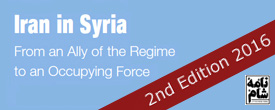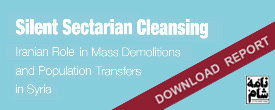 Special – Some useful resources for activists planning to organise protests and demonstrations in front of Iranian embassies on 17 April, Syria’s Independence Day, under the slogan #End_Iranian_occupation_of_Syria
Special – Some useful resources for activists planning to organise protests and demonstrations in front of Iranian embassies on 17 April, Syria’s Independence Day, under the slogan #End_Iranian_occupation_of_Syria
You find attached a simple design of a banner with a clear message in three languages: English, Arabic and Persian. We have intentionally left some space at the bottom to allow you to add your group’s or organisations name or logo.
You also find below some legal arguments about whether the Iranian interference in Syria amounts to a military occupation as defined by international law, as well as Naame Shaam’s demands to the US and its allies in this regards, which you may find useful for your press releases or leaflets.
Finally, you find some (Arabic) slogans to chant during the protests, along with the English translation. We encourage everyone to come up with new slogans and share them so that others could use them too.
See you on the streets!
Does the Iranian interference in Syria constitute a military occupation?
In its report “Iran in Syria: From an ally of the regime to an occupying force”, published in November 2014, Naame Shaam argued that the ongoing war in Syria should be treated as an international armed conflict that involves a foreign occupation by the Iranian regime and its militias and a liberation struggle by the Syrian people against this foreign occupation. The argument was based on the following observations:
1. The Iranian intervention in Syria has not been confined to supporting the Syrian government and its armed forces, which legal experts argue is not sufficient to render an armed conflict into an international one. The Iranian regime, especially Sepah Pasdaran (the Iranian Revolutionary Guards) has also been arming, training and directing irregular Syrian paramilitary forces (the shabbiha and the National Defence Forces, IDF), as well as Iran’s own paramilitary forces fighting in Syria (Sepah Qods and Basij) and all the Iranian-backed foreign militias that have assumed a leading role in major military operations in certain parts of Syria (Hezbollah Lebanon, the Iraqi and Afghani militias and so on).
2. Other states (the US, Turkey, Saudi Arabia, Qatar, etc.) have also intervened in Syria on the side of Syrian rebels. They have all played a role in “organizing, coordinating or planning the military actions of a non-state armed group.” This, according to the International Criminal Tribunal on Yugoslavia (ICTY) judgment in the 1995 case of Tadić, among others, is sufficient to internationalise a conflict.
3. The Syria war is no longer geographically confined to the territory of Syria; it has occasionally and increasingly spilled over to other neighbouring countries, especially Lebanon and Iraq.
4. The Iranian and other outside interventions have not been solely directed at non-state armed groups and their military operations or infrastructure; it has also deliberately targeted and affected Syrian civilians and civilian infrastructure. This, according to experts, renders the conflict into an international one.
5. Vast areas of the regime-controlled parts of Syria are now under the effective control of the Iranian armed forces and the militias directed by the Iranian regime. This arguably amounts to a belligerent occupation, as defined by the 1907 Hague Regulations and the Fourth Geneva Convention.
6. The Syria war could also be treated as an international conflict under Article 1(4) of Protocol I Additional to the Geneva Conventions because it now involves people, represented by a recognised authority (the Syrian opposition umbrella groups), fighting against the “colonial domination and alien occupation” of the Iranian regime and its militias.
For more details, see Chapter II of the report.
Naame Shaam’s demands to the US and its allies in relation to the Iranian occupation of Syria:
_ The international community must treat the war in Syria as an international armed conflict that involves a foreign occupation by the Iranian regime and its militias and a liberation struggle by the Syrian people against this foreign occupation, as defined by the 1907 Hague Regulations and the Fourth Geneva Convention of 1949.
_ The US and its allies must take concrete steps in line with the international ‘responsibility to protect’ norm. These will inevitably include imposing no-fly zones to protect civilians all over Syria from all forms of daily bombardment.
_ The Iranian regime must be given a serious ultimatum to pull all its forces and militias out of Syria and end all its financial and military support to the Syrian regime, or face serious consequences.
_ The US and its allies must hold those responsible for the bloodshed in Syria to account. This should include referring the situation in Syria to the International Criminal Court. Syrian, Lebanese and Iranian political leaders and military commanders like Syrian president Bashar al-Assad, Hezbollah leader Hassan Nasrallah and the head of Sepah Qods, General Qassem Soleimani, should be held responsible for war crimes and crimes against humanity committed in Syria.
For more details about these demands, see Naame Shaam’s press release for April 17.
Some new slogans to chant during protests:
يا محتل طلاع طلاع – الشعب السوري ما بيركع
Occupier, out, out – Syrian people won’t sell out (literally: kneel)
آية الله طلاع طلاع – الشعب السوري ما بيركع
Ayatollah, out, out – Syrian people won’t sell out
(‘Ayatollah’ can then be replaced with ‘Ya Khamenei’, ‘Ya Soleimani’, ‘Ya Nasrallah’ etc.)
يا خامنئي طق وموت – الحق السوري ما بيموت
Ya Khamenei, to your dismay – Syrian rights won’t go away
(‘Ayatollah’ can then be replaced as above)
فيقي فيقي متحدة – سوريا صارت محتلة
Wake up, UN, wake up – Syria is now occupied
هي مو سفارة وقنصلية – هي مكتب للحرمية
This is not an embassy – This is the office of the thieves
هي سفارة مين مين؟ – هي سفارة المحتلين
Whose embassy (is this)? – The occupiers’ embassy
ما بدنا ذخيرة ومال – بدنا بدنا الاستقلال
We don’t want weapons and money – We want inde-pen-dence
Attachments:
 English
English  فارسی
فارسی  العربية
العربية 






 On Twitter
On Twitter